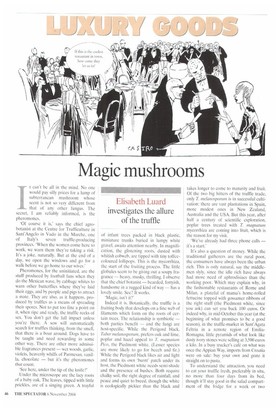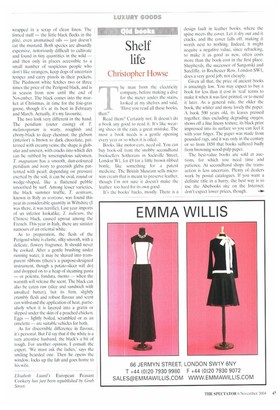Magic mushrooms
Elisabeth Luard investigates the allure of the truffle
It can't be all in the mind. No one would pay silly prices for a lump of subterranean mushroom whose scent is not so very different from that of any other fungus. The secret, I am reliably informed, is the pheromones.
'Of course it is,' says the chief agrobotanist at the Centre for Trufficulture in Sant'Angelo in Vado in the Marche, one of Italy's seven truffle-producing provinces. 'When the women come here to work, we warn them they're taking a risk. It's a joke, naturally. But at the end of a day, we open the windows and go for a walk before we go home to our wives.'
Pheromones, for the uninitiated, are the stuff produced by football fans when they do the Mexican wave, by cabbage whites to warn other butterflies where they've laid their eggs, and by people and pigs to attract a mate. They are also, as it happens, produced by truffles as a means of spreading their spores. Not to put too fine a point on it, when ripe and ready, the truffle reeks of sex. You don't get the full impact unless you're there. A sow will automatically search for truffles thinking, from the smell, that there is a boar around. Dogs have to be taught and need rewarding in some other way. There are other more admissible fragrances present — wet woods, garlic, violets, heavenly whiffs of Parmesan, vanilla, chocolate — but it's the pheromones that count.
'See here, under the tip of the knife?'
Under the microscope are the lacy roots of a baby oak. The leaves, tipped with little prickles, are of a singing green. A trayful of infant trees packed in black plastic, miniature trunks buried in lumpy white gravel, awaits attention nearby. In magnification, the glistening roots, dusted with whitish cobweb, are tipped with tiny toffeecoloured lollipops. This is the mycorrhiza, the start of the fruiting process. The little globules seem to be giving out a soupy fragrance — heavy, musky, thrilling. I observe that the chief botanist — bearded, fortyish, handsome in a rugged kind of way — has a lovely smile. See? It works.
'Magic, isn't it?'
Indeed it is. Botanically, the truffle is a fruiting body that develops on a fine web of filaments which form on the roots of certain trees. The relationship is symbiotic — both parties benefit — and the fungi are host-specific. While the Perigord black, Tuber melanosponim, prefers oak and lime, poplar and hazel appeal to T. magnatum Pico, the Piedmont white. (Lesser species are more likely to go for beech and fir.) While the Perigord black likes air and light and forms its own 'burnt' patch under its host, the Piedmont white needs semi-shade and the presence of bushes. Both require chalky soil, the right degree of rainfall, and peace and quiet to breed, though the white is ecologically pickier than the black and takes longer to come to maturity and fruit. Of the two big hitters of the truffle trade, only I melanosporum is in successful cultivation: there are vast plantations in Spain, more modest ones in New Zealand, Australia and the USA. But this year, after half a century of scientific exploration, poplar trees treated with T. magnatum mycorrhiza are coming into fruit, which is the reason for my visit.
'We've already had three phone calls — it's a start.'
It's also a question of money. While the traditional gatherers are the rural poor, the consumers have always been the urban rich. This is only natural, say the middlemen slyly, since the idle rich have always had more need of aphrodisiacs than the working poor. Which may explain why, in the fashionable restaurants of Rome and Milan, a plateful of mama's home-rolled fettucine topped with gossamer ribbons of the right stuff (the Piedmont white, since you ask) can set you back 100 euros. Or indeed why, in mid-October this year (at the beginning of what promises to be a good season), in the truffle-market in Sant'Agata Feltria in a remote region of EmiliaRomagna, little pyramids of what look like dusty ivory stones were selling at 3,500 euros a kilo. In a busy trucker's café on what was once the Appian Way, imports from Croatia were on sale: buy your own and grate it straight on to pasta.
To understand the attraction, you need to eat your truffle fresh, preferably in situ, no more than four days from its bed, though it'll stay good in the salad compartment of the fridge for a week or two wrapped in a scrap of clean linen. The tinned stuff — the little black flecks in the pate, even aromatised oils — just doesn't cut the mustard. Both species are absurdly expensive, notoriously difficult to cultivate and found in tiny quantities in the wild — and then only in places accessible to a small number of suspicious people who don't like strangers, keep dogs of uncertain temper and carry pistols in their pockets. The Piedmont white fetches two or three times the price of the Perigord black, and is in season from now until the end of November. The black comes into the market at Christmas, in time for the foie-gras goose, though it's at its best in February and March. Actually, it's my favourite.
The two look very different in the hand. The peridium (outer casing) of T melanosporum is warty, roughish and ebony-black to deep chestnut; the glebum (interior) is brown to dark chocolate, patterned with creamy veins; the shape is globular and uneven, with cracks into which dirt can be rubbed by unscrupulous salesmen. T magnatum has a smooth, dun-coloured peridium and ivory to greenish gleba patterned with pearl; depending on pressure exerted by the soil, it can be oval, round or wedge-shaped, like a flattened pebble smoothed by surf. Among lesser varieties, the black summer truffle, T aestivum, known in Italy as scorzone, was found this year in considerable quantity in Wiltshire (I was there, it was terrific). Last year imports of an inferior lookalike, T indicum, the Chinese black, caused uproar among the French. This year in Italy, there are sinister rumours of an oriental white.
As to preparation, the flesh of the Perigord white is elastic, silky smooth, with a delicate, flowery fragrance. It should never be cooked. After a gentle brushing under running water, it may be shaved into transparent ribbons (there's a purpose-designed instrument, though a potato-slicer will do) and dropped on to a heap of steaming pasta — or polenta, fonduta, risotto — when the warmth will release the scent. The black can also be eaten raw (slice and sandwich with unsalted butter), but its firm, slightly crumbly flesh and robust flavour and scent can withstand the application of heat, particularly when it is layered into a gratin or slipped under the skin of a poached chicken. Eggs — lightly boiled, scrambled or as an omelette — are suitable vehicles for both.
As for discernible difference in flavour, it's personal. But I'd say that if the white is a very attentive husband, the black's a bit of rough. For another opinion, I consult the expert. 'We must ask the ladies,' says the smiling bearded one. Then he opens the window, locks up the lab and goes home to his wife.
Elisabeth Luard's European Peasant Cookery has just been republished by Grub Street.



























































































































 Previous page
Previous page